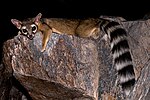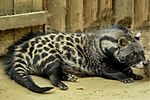 | The South American coati (Nasua nasua), also known as the ring-tailed coati, is a coati species and a member of the raccoon family (Procyonidae), found... 13 KB (1,238 words) - 04:59, 20 April 2024 |
 | The Cozumel coati (Nasua narica nelsoni), or Cozumel Island coati, is a coati from the Mexican island of Cozumel, in the Caribbean Sea. It is in the family... 4 KB (443 words) - 04:58, 20 April 2024 |
 | Nasuella (redirect from Mountain Coati) Mountain coatis are two species of procyonid mammals from the genus Nasuella. Unlike the larger coatis from the genus Nasua, mountain coatis only weigh... 7 KB (730 words) - 05:01, 20 April 2024 |
 | The South American foxes (Lycalopex), commonly called raposa in Portuguese, or zorro in Spanish, are a genus from South America of the subfamily Caninae... 9 KB (725 words) - 14:57, 17 April 2024 |
 | Nasuella olivacea (redirect from Western Mountain Coati) The western mountain coati or western dwarf coati (Nasuella olivacea) is a small procyonid, found in cloud forest and páramo at altitudes of 1,300–4,250... 4 KB (416 words) - 05:02, 20 April 2024 |
Coati Mundi may refer to: Coatimundi (sometimes Coati Mundi), or coati, two genera of mammals of the family Procyonidae native to South America, Central... 472 bytes (97 words) - 02:50, 10 January 2023 |
 | mammal that lives only on the North American continent, along its waterways and coasts. An adult North American river otter can weigh between 5.0 and... 53 KB (5,816 words) - 20:59, 15 January 2024 |
 | Nasuella meridensis (redirect from Eastern Mountain Coati) The eastern mountain coati or eastern dwarf coati (Nasuella meridensis) is a small procyonid found in cloud forest and páramo at elevations of 2,000–4... 3 KB (314 words) - 05:01, 20 April 2024 |
 | Raccoon (redirect from North American raccoon) early Miocene, the center of its distribution was probably in Central America. Coatis (Nasua and Nasuella) and raccoons (Procyon) have been considered to... 123 KB (13,433 words) - 12:00, 18 April 2024 |
 | Nasua (category Coatis) Nasua is a genus of coatis of the family Procyonidae. Two additional species of coatis, commonly known as mountain coatis, are placed in the genus Nasuella... 12 KB (1,310 words) - 04:56, 20 April 2024 |
 | Cougar (redirect from American panther) in the animal's stomach. In this area the coatí is the puma's chief prey. Despite prohibitory signs, coatis are hand-fed by tourists in the park, causing... 100 KB (10,479 words) - 05:12, 24 April 2024 |
 | Brown bear (redirect from American brown bear) migrated into North America, aligning with the glacial cycles of the Pleistocene. The founding population of most North American brown bears arrived first... 131 KB (14,712 words) - 17:23, 22 April 2024 |
 | The South American fur seal (Arctocephalus australis) breeds on the coasts of Peru, Chile, the Falkland Islands, Argentina, Uruguay and Brazil. The total... 6 KB (727 words) - 17:07, 16 April 2024 |
 | Ringtail (category Carnivorans of North America) predominantly on younger, more vulnerable specimens. Also occasional prey to coatis, lynxes, and mountain lions, the ringtail is rather adept at avoiding predators... 16 KB (1,799 words) - 04:36, 20 April 2024 |
 | The wolf-like canines and the South American canines together form the tribe Canini. Molecular data imply a North American origin of living Canidae some... 23 KB (992 words) - 22:34, 24 March 2024 |
 | Cacomistle (category Carnivorans of Central America) nocturnal, arboreal, omnivorous member of the carnivoran family Procyonidae (coatis, kinkajous and raccoons). Depending on the location, its preferred habitats... 8 KB (878 words) - 04:36, 20 April 2024 |
 | Civet (section South Asia) sub-Saharan Africa, Madagascar, the Iberian Peninsula, southern China, South and Southeast Asia. Favoured habitats include woodland, savanna, and mountain... 14 KB (1,571 words) - 18:01, 24 March 2024 |
 | American continents in the 17th century, and were used extensively from 1860 until the start of World War II to protect grain stores in the American West... 52 KB (5,550 words) - 04:09, 8 April 2024 |
 | Cozumel raccoon (category Carnivorans of North America) Cozumel Island supports several other carnivores, including the dwarf coati (Nasua narica nelsoni) and dwarf gray fox (Urocyon sp.). Islands usually... 17 KB (1,937 words) - 12:02, 18 April 2024 |











